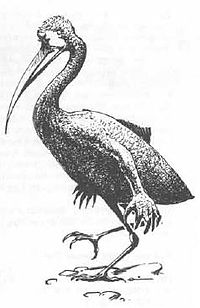
<g=4>

<g=4>
FREQUENCY: Common
FREQUENCY:
Rare ([Dungeon Level VII])
FREQUENCY:
Uncommon ([Astral Plane])
NO. APPEARING: 2-16
ARMOR CLASS: 0 or 3
MOVE: 21 or 12"
HIT DICE: 6+6 or 8+8
% IN LAIR: 25%
TREASURE TYPE: Nil
NO. OF ATTACKS: 1 or 2
DAMAGE/ATTACK: 1-12 or 2-8/2-8
SPECIAL ATTACKS: [SB]
SPECIAL DEFENSES: [SB]
MAGIC RESISTANCE: 30%
INTELLIGENCE: Low to average
ALIGNMENT: Neutral evil
(lawful)
SIZE: L or M
PSIONIC ABILITY: Nil
Attack/Defense
Modes: Nil
LEVEL/X.P. VALUE: VII |
1300 + 12
The Glooms of Hades are populated
by many monsters, the most common
of which are the diakka.
Diakka, unlike hordlings (the next most
frequently encountered inhabitant
of these planes), are more organized
and dislike erratic behavior.
The usual attack made by
diakka when confronted by obviously strong
opponents is to attempt
to force them into a compact group. The diakka
surround the opponents and
use audible glamer to make it sound as if
more diakka were coming.
The largest diakka bound in and out of melee
usingjump and weakness as
appropriate. If at least 4of these creatures
succeed in circling the
opponents while giving out their odd hooting
calls andcroaksfor4consecutive
rounds, the soundsand rhythm of this
circling danceevoke an hypnoticenfeeblementwhich
hasanarea effect
identical to the ray of
enfeeblement spell. Each subject, regardless of
magic resistance, must save
vs. spell or become enfeebled as if bya 13th
level magic-user, ie., 40%
strength loss for 13 rounds. Once opponents
are thus affected, individual
diakka use physical attacks and remaining
spell-like powers to kill
the prey, and then the whole flock feasts.
Although these creatures
are not too bright, diakka will not attack
stupidly. Upon initial contact,
the flocks strongest members will assess
those encountered for intent
and weakness. Weakness will get an
opponent in far more peril
than hostile intent. Very powerful, hostile
creatures will only be attacked
if some form of appeasement will not
work. No diakkdesires to
be slain, regardless if it is eaten or not (as they
often are by hordlings and
other creatures found on the planes). Even
other flocks are distrusted,
because of the strong rule. Occasionally a
diakk will be found on the
Prime Material Plane. The appearance is
always due to summoning.
Nighthags (q.v.) frequently use diakka as
guards. Diakka speak the
hateful tongue common to Hades. They also
speak their own language.
There are two sorts of diakka,
the tall (HD 6+6) and the broad (HD 8+8).
The differences between
the two are noted below, but they are not
otherwise separate races,
and any group will have an equal or nearly
equal mixture of both sorts.
In their lair there will always be 13-1 6 of
these creatures.
While a tall diakk can deliver
a vicious stabbing attack with its long,
sharp bill, and the broad
diakk tears with its clawed arms, both sorts of
diakkacanalsoemploythefollowingspell-Iikepowers,1
ata time, 1 per
round, atwill: weakness
bytouch inattack(1 perday), jump(2 per day),
audible glamer(1 per day),
and enfeeblement by group only (see above).
Tall diakka resemble huge
storkswith bills, human-like heads and faces,
and thin, human-like arms.
Broad diakka resemble huge, squat pelicans
with foreshortened bills
on human-like heads. Instead of wings, these
creatures have short, thickarms
with huge, curving claws. Feather color
is in sickening hues and
combinations and varies wildly, including pea
green and rusty-red orange,
purple and orange and pink, and dirty
yellow. Heads are feathered,
but faces are brightly colored and featherless.
Legs, bills, feet, claws,
etc., are usually black, dark brown, maroon,
or deep green. Tall diakka
are very fast and give loon-like cries. Broad
diakka are rather slow.
They make gobbling croaks and caws while
attacking.